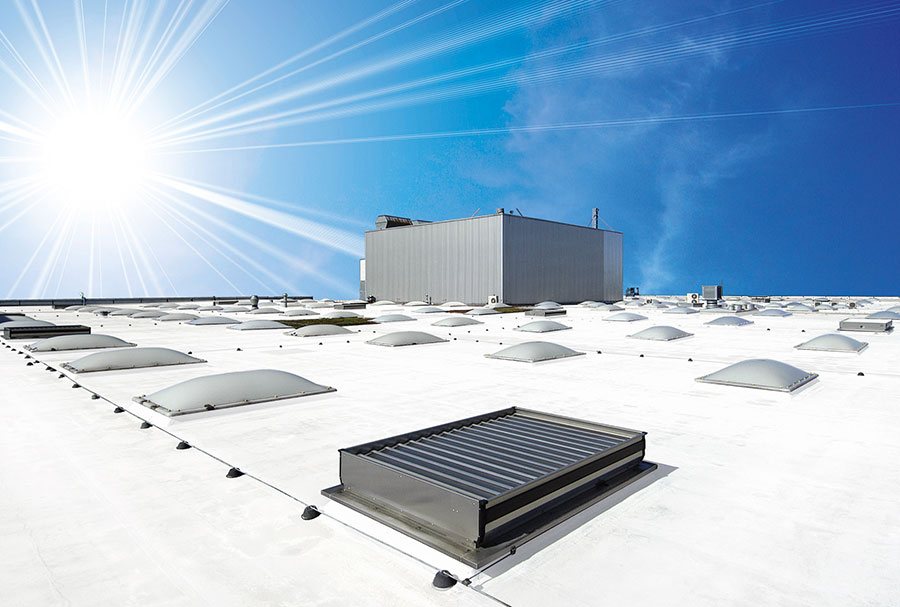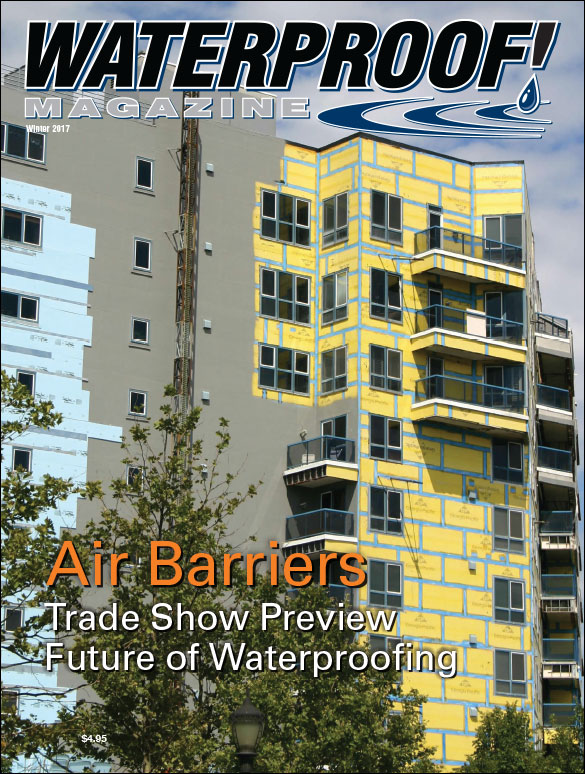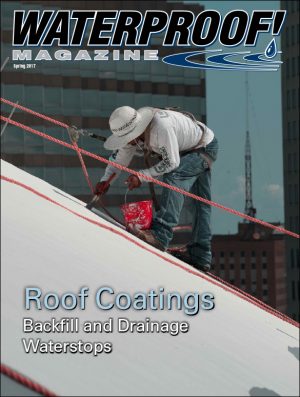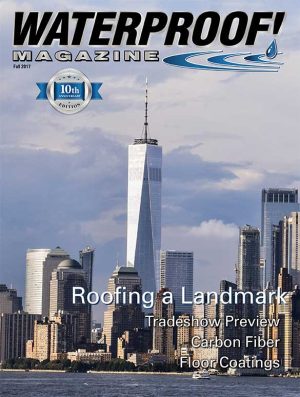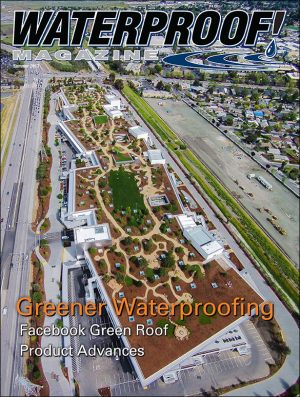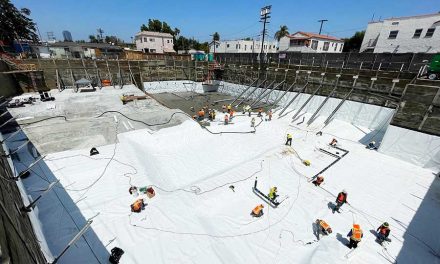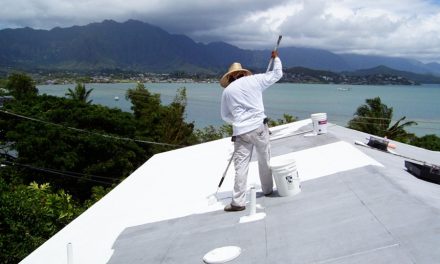Reflective single-ply roof membranes are projected to gain significant share of the market in the years ahead.
Waterproofing is a tough industry. Success requires the skill and technical knowledge of a master tradesman mixed with the business acumen and work ethic of an entrepreneur.
Part of the difficulty stems from the cyclical nature of waterproofing. Economic cycles, building booms, weather conditions, the competition, and building codes all play a role. In the years ahead, green building mandates, changing insulation requirements, and tighter building envelopes will be changing the face of the waterproofing industry. Let’s examine a few of these trends.
Economics
For those waterproofers who focus primarily on new construction, the coming year looks to be good for business. In the U.S., single-family housing continues to grow at a moderate pace, and building permits indicate even further growth in the months ahead. Low interest rates, easier lending standards, and modest economic growth are fueling the increase.
Jonathan Smoke, chief economist at realtor.com in Washington D.C., says, “Permits are outpacing starts, which indicates that developers and builders are finally planning for more growth ahead. That’s great news for both the economy and the consumer.”
Multifamily construction has slowed, but that’s expected to be temporary, as rents across the nation are rising and vacant units are hard to come by.
In the commercial market, experts predict that conditions will be about the same as they have been the last few years. Robert Murray, chief economist for Dodge Data & Analytics points out that the current construction recovery really didn’t begin until 2012, well after the overall economy started to rebound. “This is a very measured upturn,” he said. “It’s not a boom.”
Fortunately, the waterproofing industry is set to outperform the construction industry as a whole. John Bryant, general manager for Aquaguard Waterproofing and president of the Basement Health Association estimates that there’s a considerable backlog of waterproofing work that’s been deferred during the recession, as well as significant chunk of work that will need to be redone.
“When the bottom fell out of the construction market, some builders tried to do the waterproofing themselves, and in many cases, it was work they weren’t trained in,” he explains. “Builders specialize in building homes, not waterproofing. Additionally, during the recession, a lot of homeowners were doing things more cheaply just to get by. In many cases, it has come back to get them.”
Now that the economy has improved and stabilized, he says “homeowners are willing to spend more money if the situation warrants it.”
Consumer budgets are still tight, however. The most successful builders and owners are those who can deliver maximum performance per dollar. Products that offer state-of-the-art performance at affordable prices have the advantage. This same factor is driving the popularity of finishing out basements, as it creates more living space affordably.
It appears that many clients have learned that the low bid might not be the best. “They’d rather have quality and service than just price,” he says. “Even the government is shifting to a progressive bid system, and will often choose something other than the low bid, if the contractor can explain why the more expensive upfront method will save money in the long run.”
Diversification
Residential waterproofing is changing, with an emphasis on better products, better technology, and better craftsmanship. For instance, carbon fiber is revolutionizing basement crack repair. The technology has been around for more than a decade, but it is now widely accepted and cost-competitive.
The successful waterproofing companies in the future will offer a broad range of basement repair services, which will help smooth out the bumps of cyclical waterproofing.

Conditioned basements and crawlspaces have become best practice, especially in humid climates, creating a major opportunity for waterproofing companies.
Bryant says, “The old way of thinking with the waterproofing contractor, is ‘you’ve got a great business when it’s raining, but when it dries up, hang on.’ At the BHA, we’ve been talking with members about diversification. They have to offer other services.”
A few years ago, the Environmental Protection Agency (EPA) published a bulletin indicating that most indoor air was five times more polluted than outside air, and that traditional crawlspaces—a vent on each end of the building and a loose vapor barrier spread over the ground—were one major reason.
In the past few years, conditioned crawlspaces have become best practice, especially in humid climates. Enclosed basements are gaining in popularity for the same reason: it reduces radon, moisture, and unpleasant smells. The shift creates a major opportunity for waterproofing companies.
Mold, which was such a major focus 10 years ago, is less of an issue now, since builders understand the importance of air quality and restricting air flow within the crawlspace.
As part of the move to cleaner air, many waterproofing companies also offer dehumidifiers and air purifiers. “These have flooded the market, and for a really good reason,” says Bryant. “By enclosing the crawlspace and making it part of the home, humidity, mold, mildew, and radon are eliminated from the living space. These technologies can resolve what’s known as ‘sick home syndrome’. This whole move to healthier indoor air is a major reason we changed the name of our association from the National Association of Waterproofers and Structural Repair Contractors to the Basement Health Association.”

Carbon fiber is revolutionizing basement crack repair. The technology has gained wide acceptance and is cost-competitive.
Regulations
Egress windows are another huge untapped market for waterproofers. In this case, the change is driven by code mandates, as they are required in all basement remodels.
Similar changes are happening in the sump pump arena. An increasing number of municipalities are requiring that sump pumps be installed by someone with a master plumbers license. Bryant says, “Frequently, waterproofers know more about sumps than the plumbers. Additionally, a master plumber license requires years of training. I understand they’re just trying to protect the homeowner, but this really could be devastating to waterproofing companies.”
In response, the BHA is developing a certified sump pump specialist designation and working with municipalities across the nation to accept this certificate as proof of competency.
The association has already developed a Basement Air Quality Specialist designation and a Certified Egress Specialist designation as well. Bryant says, “We really want to help our members learn to diversify and create sustainable businesses.”
Green Building
Green building is one of the few sectors of the construction market that has experienced virtually uninterrupted growth over the past decade. What was once voluntary is becoming mandatory. Building codes are insisting on more insulation, both above and below grade. (The new 2012 International Building Code is 30% more efficient than the 2006 code.) In practice, this means more rigid foam insulation above and below grade, so waterproofing systems must adapt to be compatible.
Similarly, codes are requiring tighter buildings with less natural air flow, so above-grade air barriers are becoming more common. Housewraps now have to perform better, and detailing is becoming more of an issue. Spray-on air and vapor barriers, once seen only on commercial projects, are beginning to make inroads in the residential market.
On commercial jobs, air barriers have become standard practice. The biggest green building trend in the commercial market is taking place on the rooftops. Green trends are also driving demand for cool roofs, reflective roofs, and green (vegetative) roofs.
Across all segments of the waterproofing industry, green waterproofing products— meaning those that are recyclable, low-VOC, or rubber/polymer-based instead of asphalt/solvent based—are doing relatively better than those that aren’t.
Bryant says, “A lot of counties, municipalities and townships cater to those who emphasize green or sustainable construction. Manufacturers are looking at substances that more sustainable or environmentally friendly, discourage mold growth, etc. It’s a trend of interest to the homeowner, but more especially to commercial clients. Many of them ask about it and insist on it.”
The growing emphasis on long-term, life-cycle costs is favorable to waterproofing contractors who focus on quality and craftsmanship, and the green/sustainable building movement will give environmentally-friendly products an edge.

Roof coatings eliminate the need to tear off and replace aging roofs, extending their life by 10 or 15 years.
Innovation
The cost of construction continues to rise, driven by escalating raw material and labor costs. In response, project developers and owners are increasingly choosing cutting-edge waterproofing products and solutions. Commercial roofing, discussed above, is one example.
But the same trend holds true in all aspects of waterproofing. Crystalline admixtures, polyurethane coatings, acrylic polymer-based cementitious coatings are all gaining in popularity. For drainage, there’s a move away from the historic straw-and-gravel approach to more modern materials, such as dimple drain sheets, perforated pipe, and geotextile systems.
Customers and contractors are insisting on better and more sophisticated sump pumps, too, with back-up power, wireless alerts and alarms, and capable of autodialing the owners phone if they’re disabled. In years to come, battery back-up sump pumps may be driven by small lithium batteries, the same technology that powers smartphones.
Bryant says that contractors will need to be better educated and willing to change. “The successful companies are out there finding new ideas and custom designing solutions to meet the customers’ needs,” he says.
In the end though, it still comes down to the man behind the tool. “I’m a firm believer that, at the end of the day, it’s the workmanship that makes the difference,” says Bryant. “I’ve installed them all, and I’ve seen what works at what doesn’t. And when it doesn’t, it’s rarely the product. It’s usually the workmanship.”
Winter 2017 Back Issue
$4.95
Insulation, Air Barriers, and Waterproofing
AVAILABLE AS DIGITAL DOWNLOAD ONLY
Description
Description
Additional Info
Additional information
| Magazine Format | Digital Download Magazine, Print Mailed Magazine |
|---|

